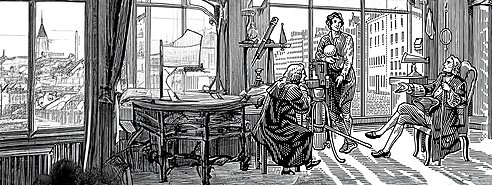In this article, Chelsea Follett describes why the small university city of Edinburgh, Scotland, was such an important intellectual center in the Enlightenment. During this period, scrappy Edinburgh produced such giants as David Hume, Adam Smith, and James Watt, historical figures who have had a profound impact on our world.


- What do you already know about Edinburgh, Scotland? Build your schema about the city by taking a virtual walking tour of Edinburgh. Watch these videos: The Royal Mile, New Town, and the famous Edinburgh Castle.
- How has Adam Smith influenced Americans? Watch this video to see how Smith’s economic philosophy has impacted the United States. Then discuss these questions:
- What do you admire about Smith’s philosophy?
- What are some potential problems that may stem from Americans’ embrace of Smith’s ideas?
- In your opinion, how “Smithian” is the United States?
Questions for Reading, Writing, and Discussion
Read the article, and then answer the following questions:
- What social and institutional factors contributed to Scotland having one of the highest literacy rates in the world during the 1700s?
- In what ways did Scottish Enlightenment architects influence American architects in the 19th century?
- What have been some of the impacts of the scientific discoveries made at Edinburgh during the Scottish Enlightenment? Use your historical knowledge to complete the chart below.
Look at each field in the left column. Write the discoveries made in that field during the Scottish Enlightenment in the middle column. Write at least two impacts of that discovery on subsequent history in the right column.
| Field | Discovery | Two Impacts of the Discovery |
| Chemistry and Physics | ||
| Medicine | ||
| Math and Engineering | ||
| Philosophy | ||
| Economics |
- According to the article, what were the four qualities that characterized the Scottish philosophical outlook during the Enlightenment?
Extension Activity/Homework
- Create a “Butterfly Effect” Poster
The butterfly effect is an idea used in chaos theory. It states that a small change can precipitate much bigger ones in the future. In the study of history, it’s obvious that one event or person can have an outsize effect on the future.
Choose one of the Scottish Enlightenment thinkers to research in depth. Learn about their legacy and think about how that person’s ideas and innovations are still shaping the world today.
Create a poster showcasing 7–10 developments from history that can be connected chain‐like to a particular Scottish Enlightenment thinker. Each development should have a clear link with the preceding item. Be creative and come up with novel connections between seemingly disparate events.
- Write a Personal Essay about a Scottish Enlightenment Idea
Imagine The Scottish Enlightenment produced some of the greatest thinkers in history, including David Hume and Adam Smith. Their ideas have had far‐reaching effects on science, philosophy, political science, and economics.
Research one of the “big names” of the Scottish Enlightenment and choose one of that person’s ideas that is particularly compelling or motivating to you. Write a personal essay on why that philosopher’s idea is relevant to your own life